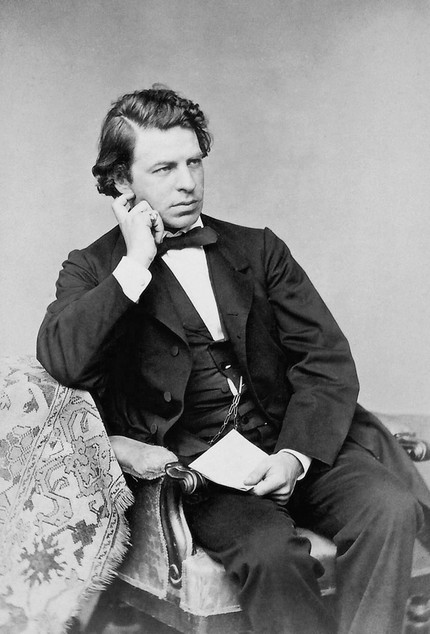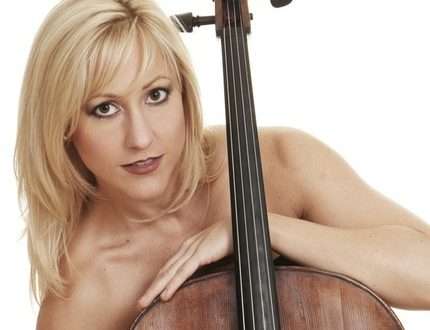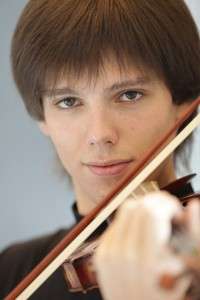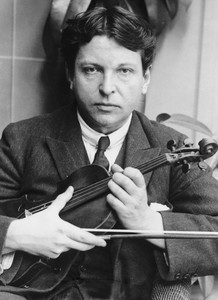
Joseph Joachim (Joseph Joachim) |
Joseph Joachim

There are individuals who diverge with time and the environment in which they are forced to live; there are individuals who surprisingly harmonize subjective qualities, worldview and artistic demands with the defining ideological and aesthetic trends of the era. Among the latter belonged to Joachim. It was “according to Joachim”, as the greatest “ideal” model, that the music historians Vasilevsky and Moser determined the main signs of the interpretive trend in the violin art of the second half of the XNUMXth century.
Josef (Joseph) Joachim was born on June 28, 1831 in the town of Kopchen near Bratislava, the present capital of Slovakia. He was 2 years old when his parents moved to Pest, where, at the age of 8, the future violinist began taking lessons from the Polish violinist Stanislav Serwaczyński, who lived there. According to Joachim, he was a good teacher, although with some defects in his upbringing, mainly in relation to the technique of the right hand, Joachim subsequently had to fight. He taught Joachim using the studies of Bayo, Rode, Kreutzer, the plays of Berio, Maiseder, etc.
In 1839 Joachim comes to Vienna. The Austrian capital shone with a constellation of remarkable musicians, among whom Josef Böhm and Georg Helmesberger especially stood out. After several lessons from M. Hauser, Joachim goes to Helmesberger. However, he soon abandoned it, deciding that the right hand of the young violinist was too neglected. Fortunately, W. Ernst became interested in Joachim and recommended that the boy’s father turn to Bem.
After 18 months of classes with Bem, Joachim made his first public appearance in Vienna. He performed Ernst’s Othello, and criticism noted the extraordinary maturity, depth, and completeness of the interpretation for a child prodigy.
However, Joachim owes the true formation of his personality as a musician-thinker, musician-artist not to Boehm and, in general, not to Vienna, but to the Leipzig Conservatory, where he went in 1843. The first German conservatory founded by Mendelssohn had outstanding teachers. Violin classes in it were headed by F. David, a close friend of Mendelssohn. Leipzig during this period turned into the largest musical center in Germany. Its famous Gewandhaus concert hall attracted musicians from all over the world.
The musical atmosphere of Leipzig had a decisive influence on Joachim. Mendelssohn, David and Hauptmann, from whom Joachim studied composition, played a huge role in his upbringing. Highly educated musicians, they developed the young man in every possible way. Mendelssohn was captivated by Joachim at the first meeting. Hearing his Concerto performed by him, he was delighted: “Oh, you are my angel with a trombone,” he joked, referring to a fat, rosy-cheeked boy.
There were no specialty classes in David’s class in the usual sense of the word; everything was limited to the advice of the teacher to the student. Yes, Joachim did not have to be “taught”, since he was already a technically trained violinist in Leipzig. Lessons turned into home music with the participation of Mendelssohn, who willingly played with Joachim.
3 months after his arrival in Leipzig, Joachim performed in one concert with Pauline Viardot, Mendelssohn and Clara Schumann. On May 19 and 27, 1844, his concerts took place in London, where he performed the Beethoven Concerto (Mendelssohn conducted the orchestra); On May 11, 1845, he played Mendelssohn’s Concerto in Dresden (R. Schumann conducted the orchestra). These facts testify to the unusually quick recognition of Joachim by the greatest musicians of the era.
When Joachim turned 16, Mendelssohn invited him to take a position as a teacher at the conservatory and concertmaster of the Gewandhaus orchestra. The latter Joachim shared with his former teacher F. David.
Joachim had a hard time with the death of Mendelssohn, which followed on November 4, 1847, so he willingly accepted Liszt’s invitation and moved to Weimar in 1850. He was also attracted here by the fact that during this period he was passionately carried away by Liszt, strove for close communication with him and his circle. However, having been brought up by Mendelssohn and Schumann in strict academic traditions, he quickly became disillusioned with the aesthetic tendencies of the “new German school” and began to critically evaluate Liszt. J. Milstein rightly writes that it was Joachim who, following Schumann and Balzac, laid the foundation for the opinion that Liszt was a great performer and a mediocre composer. “In every note of Liszt one can hear a lie,” wrote Joachim.
The disagreements that had begun gave rise to a desire in Joachim to leave Weimar, and in 1852 he went with relief to Hannover to take the place of the deceased Georg Helmesberger, the son of his Viennese teacher.
Hanover is an important milestone in the life of Joachim. The blind Hanoverian king was a great lover of music and highly appreciated his talent. In Hannover, the pedagogical activity of the great violinist was fully developed. Here Auer studied with him, according to whose judgments it can be concluded that by this time Joachim’s pedagogical principles had already been sufficiently determined. In Hanover, Joachim created several works, including the Hungarian Violin Concerto, his best composition.
In May 1853, after a concert in Düsseldorf where he performed as a conductor, Joachim became friends with Robert Schumann. He maintained connections with Schumann until the composer’s death. Joachim was one of the few who visited the sick Schumann in Endenich. His letters to Clara Schumann have been preserved about these visits, where he writes that at the first meeting he had hope for the composer’s recovery, however, it finally faded away when he came a second time: “.
Schumann dedicated the Fantasia for Violin (op. 131) to Joachim and handed over the manuscript of the piano accompaniment to Paganini’s caprices, which he had been working on in the last years of his life.
In Hannover, in May 1853, Joachim met Brahms (then an unknown composer). At their first meeting, an exceptionally cordial relationship was established between them, cemented by an amazing commonality of aesthetic ideals. Joachim handed Brahms a letter of recommendation to Liszt, invited the young friend to his place in Göttingen for the summer, where they listened to lectures on philosophy at the famous university.
Joachim played a big role in the life of Brahms, doing a lot to recognize his work. In turn, Brahms had a huge impact on Joachim in artistic and aesthetic terms. Under the influence of Brahms, Joachim finally broke with Liszt and took an ardent part in the unfolding struggle against the “new German school”.
Along with hostility to Liszt, Joachim felt even greater antipathy towards Wagner, which, by the way, was mutual. In a book on conducting, Wagner “dedicated” very caustic lines to Joachim.
In 1868, Joachim settled in Berlin, where a year later he was appointed director of the newly opened conservatory. He remained in this position until the end of his life. From the outside, any major events are no longer recorded in his biography. He is surrounded by honor and respect, students from all over the world flock to him, he conducts intense concert – solo and ensemble – activities.
Twice (in 1872, 1884) Joachim came to Russia, where his performances as a soloist and quartet evenings were held with great success. He gave Russia his best student, L. Auer, who continued here and developed the traditions of his great teacher. Russian violinists I. Kotek, K. Grigorovich, I. Nalbandyan, I. Ryvkind went to Joachim to improve their art.
On April 22, 1891, Joachim’s 60th birthday was celebrated in Berlin. Honoring took place at the anniversary concert; the string orchestra, with the exception of double basses, was selected exclusively from the students of the hero of the day – 24 first and the same number of second violins, 32 violas, 24 cellos.
In recent years, Joachim worked a lot with his student and biographer A. Moser on the editing of sonatas and partitas by J.-S. Bach, Beethoven’s quartets. He took a great part in the development of the violin school of A. Moser, so his name appears as a co-author. In this school, his pedagogical principles are fixed.
Joachim died on August 15, 1907.
The biographers of Joachim Moser and Vasilevsky evaluate his activities extremely tendentiously, believing that it is he who has the honor of “discovering” the violin Bach, popularizing the Concerto and Beethoven’s last quartets. Moser, for example, writes: “If thirty years ago only a handful of experts were interested in the last Beethoven, now, thanks to the tremendous persistence of the Joachim Quartet, the number of admirers has increased to wide limits. And this applies not only to Berlin and London, where the Quartet constantly gave concerts. Wherever the master’s students live and work, up to America, the work of Joachim and his Quartet continues.
So the epochal phenomenon turned out to be naively attributed to Joachim. The emergence of interest in the music of Bach, the violin concerto and Beethoven’s last quartets was happening everywhere. It was a general process that developed in European countries with a high musical culture. Fixing the works of J.-S. Bach, Beethoven on the concert stage really takes place in the middle of the XNUMXth century, but their propaganda begins long before Joachim, paving the way for his activities.
Beethoven’s concerto was performed by Tomasini in Berlin in 1812, by Baio in Paris in 1828, by Viettan in Vienna in 1833. Viet Tang was one of the first popularizers of this work. The Beethoven Concerto was successfully performed in St. Petersburg by L. Maurer in 1834, by Ulrich in Leipzig in 1836. In the “revival” of Bach, the activities of Mendelssohn, Clara Schumann, Bulow, Reinecke and others were of great importance. As for Beethoven’s last quartets, before Joachim they paid much attention to the Joseph Helmesberger Quartet, which in 1858 ventured to publicly perform even the Quartet Fugue (Op. 133 ).
Beethoven’s last quartets were included in the repertoire of the ensemble headed by Ferdinand Laub. In Russia, Lipinski’s performance of the last Beethoven quartets in the Dollmaker’s house in 1839 captivated Glinka. During their stay in St. Petersburg, they were often played by Vietanne in the houses of the Vielgorskys and Stroganovs, and since the 50s they have firmly entered the repertoire of the Albrecht, Auer, and Laub Quartets.
The mass distribution of these works and interest in them became really possible only from the middle of the XNUMXth century, not because Joachim appeared, but because of the social atmosphere created at that time.
Justice requires, however, to recognize that there is some truth in Moser’s assessment of the merits of Joachim. It lies in the fact that Joachim really played an outstanding role in the dissemination and popularization of the works of Bach and Beethoven. Their propaganda was undoubtedly the work of his entire creative life. In defending his ideals, he was principled, never compromised in matters of art. On the examples of his passionate struggle for the music of Brahms, his relationship to Wagner, Liszt, you can see how steadfast he was in his judgments. This was reflected in the aesthetic principles of Joachim, who gravitated towards the classics and accepted only a few examples from virtuoso romantic literature. His critical attitude towards Paganini is known, which is generally similar to the position of Spohr.
If something disappointed him even in the work of composers close to him, he remained in positions of objective adherence to principles. The article by J. Breitburg about Joachim says that, having discovered a lot of “non-Bachian” in Schumann’s accompaniment to Bach’s cello suites, he spoke out against their publication and wrote to Clara Schumann that one should not “with condescension add … a withered leaf” to the composer’s immortality wreath . Considering that Schumann’s violin concerto, written six months before his death, is significantly inferior to his other compositions, he writes: “How bad it is to allow reflection to dominate where we are accustomed to love and respect with all our heart!” And Breitburg adds: “He carried this purity and ideological strength of principled positions in music unsullied through his entire creative life.”
In his personal life, such adherence to principles, ethical and moral severity, sometimes turned against Joachim himself. He was a difficult person for himself and those around him. This is evidenced by the story of his marriage, which cannot be read without a feeling of chagrin. In April 1863, Joachim, while living in Hannover, became engaged to Amalia Weiss, a talented dramatic singer (contralto), but made it a condition of their marriage to give up a stage career. Amalia agreed, although she internally protested against leaving the stage. Her voice was highly regarded by Brahms, and many of his compositions were written for her, including Alto Rhapsody.
However, Amalia could not keep her words and devote herself entirely to her family and husband. Soon after the wedding, she returned to the concert stage. “The marital life of the great violinist,” writes Geringer, “gradually became unhappy, as the husband suffered from an almost pathological jealousy, constantly kindled by the lifestyle that Madame Joachim was naturally forced to lead as a concert singer.” The conflict between them especially escalated in 1879, when Joachim suspected his wife of having close relations with the publisher Fritz Simrock. Brahms intervenes in this conflict, absolutely convinced of Amalia’s innocence. He persuades Joachim to come to his senses and in December 1880 sends a letter to Amalia, which subsequently served as the reason for the break between friends: “I never justified your husband,” wrote Brahms. “Even before you, I knew the unfortunate trait of his character, thanks to which Joachim so unforgivably torments himself and others” … And Brahms expresses the hope that everything will still be formed. Brahms’ letter figured in the divorce proceedings between Joachim and his wife and deeply offended the musician. His friendship with Brahms came to an end. Joachim divorced in 1882. Even in this story, where Joachim is absolutely wrong, he appears as a man of high moral principles.
Joachim was the head of the German violin school in the second half of the XNUMXth century. The traditions of this school go back through David to Spohr, highly revered by Joachim, and from Spohr to Roda, Kreutzer and Viotti. Viotti’s twenty-second concerto, the concertos of Kreutzer and Rode, Spohr and Mendelssohn formed the basis of his pedagogical repertoire. This was followed by Bach, Beethoven, Mozart, Paganini, Ernst (in very moderate doses).
Bach’s compositions and Beethoven’s Concerto occupied a central place in his repertoire. Of his performance of the Beethoven Concerto, Hans Bülow wrote in the Berliner Feuerspitze (1855): “This evening will remain unforgettable and the only one in the memory of those who had this artistic pleasure that filled their souls with deep delight. It was not Joachim who played Beethoven yesterday, Beethoven himself played! This is no longer the performance of the greatest genius, this is revelation itself. Even the greatest skeptic must believe the miracle; no such transformation has yet taken place. Never before has a work of art been perceived so vividly and enlightenedly, never before has immortality been transformed into the brightest reality so sublimely and radiantly. You should be on your knees listening to this kind of music.” Schumann called Joachim the best interpreter of Bach’s miraculous music. Joachim is credited with the first truly artistic edition of Bach’s sonatas and scores for solo violin, the fruit of his enormous, thoughtful work.
Judging by the reviews, softness, tenderness, romantic warmth prevailed in Joachim’s game. It had a relatively small but very pleasant sound. Stormy expressiveness, impetuosity were alien to him. Tchaikovsky, comparing the performance of Joachim and Laub, wrote that Joachim is superior to Laub “in the ability to extract touchingly tender melodies”, but inferior to him “in the power of tone, in passion and noble energy.” Many reviews emphasize the restraint of Joachim, and Cui reproaches him even for coldness. However, in reality it was the masculine severity, simplicity and rigor of the classic style of play. Recalling the performance of Joachim with Laub in Moscow in 1872, the Russian music critic O. Levenzon wrote: “We especially remember the Spohr duet; this performance was a true contest between two heroes. How the calm classical playing of Joachim and the fiery temperament of Laub affected this duet! As now we remember the bell-shaped sound of Joachim and the burning cantilena of Laub.
“A stern classic, a “Roman,” called Joachim Koptyaev, drawing his portrait for us: “A well-shaven face, a wide chin, thick hair combed back, restrained manners, a lowered look – they completely gave the impression of a pastor. Here is Joachim on the stage, everyone held their breath. Nothing elemental or demonic, but strict classical calmness, which does not open spiritual wounds, but heals them. A real Roman (not of the era of decline) on the stage, a stern classic – that’s the impression of Joachim.
It is necessary to say a few words about Joachim the ensemble player. When Joachim settled in Berlin, here he created a quartet that was considered one of the best in the world. The ensemble included, in addition to Joachim G. de Ahn (later replaced by K. Galirzh), E. Wirth and R. Gausman.
About Joachim the quartetist, in particular about his interpretation of Beethoven’s last quartets, A. V. Ossovsky wrote: “In these creations, captivating in their sublime beauty and overwhelming in their mysterious depth, the genius composer and his performer were brothers in spirit. No wonder Bonn, the birthplace of Beethoven, presented Joachim in 1906 with the title of honorary citizen. And just what other performers break down on – Beethoven’s adagio and andante – it was they who gave Joachim space to deploy all his artistic power.
As a composer, Joachim did not create anything major, although Schumann and Liszt highly valued his early compositions, and Brahms found that his friend “has more than all other young composers put together.” Brahms revised two of Joachim’s overtures for piano.
He wrote a number of pieces for violin, orchestra and piano (Andante and Allegro op. 1, “Romance” op. 2, etc.); several overtures for orchestra: “Hamlet” (unfinished), to Schiller’s drama “Demetrius” and to Shakespeare’s tragedy “Henry IV”; 3 concertos for violin and orchestra, of which the best is the Concerto on Hungarian Themes, often performed by Joachim and his students. Joachim’s editions and cadences were (and have been preserved to the present day) – the editions of Bach’s sonatas and partitas for solo violin, the arrangement for violin and piano of Brahms’ Hungarian Dances, the cadenzas to the concertos of Mozart, Beethoven, Viotti, Brahms, used in modern concert and teaching practice.
Joachim took an active part in the creation of the Brahms Concerto and was its first performer.
The creative portrait of Joachim would be incomplete if his pedagogical activity is passed over in silence. Joachim’s pedagogy was highly academic and strictly subordinated to the artistic principles of educating students. An opponent of mechanical training, he created a method that in many ways paved the way for the future, as it was based on the principle of the unity of the student’s artistic and technical development. The school, written in collaboration with Moser, proves that in the early stages of learning, Joachim groped for elements of the auditory method, recommending such techniques for improving the musical ear of novice violinists as solfegging: “It is extremely important that the student’s musical presentation be first cultivated. He must sing, sing and sing again. Tartini has already said: “Good sound requires good singing.” A beginner violinist should not extract a single sound that he has not previously reproduced with his own voice … “
Joachim believed that the development of a violinist is inseparable from a broad program of general aesthetic education, outside of which a genuine improvement of artistic taste is impossible. The requirement to reveal the composer’s intentions, objectively convey the style and content of the work, the art of “artistic transformation” – these are the unshakable foundations of Joachim’s pedagogical methodology. It was the artistic power, the ability to develop artistic thinking, taste, and understanding of music in the student that Joachim was great as a teacher. “He,” writes Auer, “was a real revelation for me, revealing before my eyes such horizons of higher art that I could not guess until then. Under him, I worked not only with my hands, but also with my head, studying the scores of composers and trying to penetrate into the very depths of their ideas. We played a lot of chamber music with our comrades and mutually listened to solo numbers, sorting out and correcting each other’s mistakes. In addition, we took part in symphony concerts conducted by Joachim, which we were very proud of. Sometimes on Sundays, Joachim held quartet meetings, to which we, his students, were also invited.”
As for the technology of the game, it was given an insignificant place in Joachim’s pedagogy. “Joachim rarely entered into technical details,” we read from Auer, “never explained to his students how to achieve technical ease, how to achieve this or that stroke, how to play certain passages, or how to facilitate performance by using certain fingerings. During the lesson, he held the violin and the bow, and as soon as the performance of a passage or a musical phrase by a student did not satisfy him, he brilliantly played a dubious place himself. He rarely expressed himself clearly, and the only remark he uttered after playing a failed student’s place was: “You have to play it like that!”, accompanied by a reassuring smile. Thus, those of us who were able to understand Joachim, to follow his obscure directions, benefited greatly from trying to imitate him as much as we could; others, less happy, remained standing, not understanding anything … “
We find confirmation of Auer’s words in other sources. N. Nalbandian, having entered the class of Joachim after the St. Petersburg Conservatory, was surprised that all the students hold the instrument in different ways and at random. Correction of staging moments, according to him, did not interest Joachim at all. Characteristically, in Berlin, Joachim entrusted the technical training of students to his assistant E. Wirth. According to I. Ryvkind, who studied with Joachim in the last years of his life, Wirth worked very carefully, and this significantly made up for the shortcomings of Joachim’s system.
The disciples adored Joachim. Auer felt touching love and devotion for him; he devoted warm lines to him in his memoirs, sent his students for improvement at a time when he himself was already a world-famous teacher.
“I played a Schumann concerto in Berlin with the Philharmonic Orchestra conducted by Arthur Nikisch,” recalls Pablo Casals. “After the concert, two men slowly approached me, one of whom, as I had already noticed, could not see anything. When they were in front of me, the one who was leading the blind man by the arm said: “You don’t know him? This is Professor Wirth” (violist from the Joachim Quartet).
You need to know that the death of the great Joachim created such a gap among his comrades that until the end of their days they could not come to terms with the loss of their maestro.
Professor Wirth silently began feeling my fingers, arms, chest. Then he hugged me, kissed me and softly said in my ear: “Joachim is not dead!”.
So for the companions of Joachim, his students and followers, he was and remains the highest ideal of violin art.
L. Raaben





